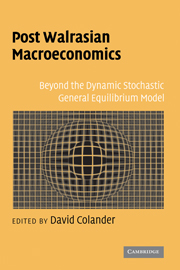Book contents
- Frontmatter
- Contents
- List of Contributors
- Foreword by Alan Kirman
- Introduction
- PART I WHERE WE ARE IN MACRO AND HOW WE GOT THERE
- PART II EDGING AWAY FROM THE DSGE MODEL
- PART III LEAPING AWAY FROM THE DSGE MODEL
- 9 Agent-Based Computational Modeling and Macroeconomics
- 10 Multi-agent Systems Macro: A Prospectus
- 11 Agent-Based Financial Markets: Matching Stylized Facts with Style
- PART IV LETTING THE DATA GUIDE THEORY
- PART V POLICY IMPLICATIONS
- Bibliography
- Index
9 - Agent-Based Computational Modeling and Macroeconomics
Published online by Cambridge University Press: 02 December 2009
- Frontmatter
- Contents
- List of Contributors
- Foreword by Alan Kirman
- Introduction
- PART I WHERE WE ARE IN MACRO AND HOW WE GOT THERE
- PART II EDGING AWAY FROM THE DSGE MODEL
- PART III LEAPING AWAY FROM THE DSGE MODEL
- 9 Agent-Based Computational Modeling and Macroeconomics
- 10 Multi-agent Systems Macro: A Prospectus
- 11 Agent-Based Financial Markets: Matching Stylized Facts with Style
- PART IV LETTING THE DATA GUIDE THEORY
- PART V POLICY IMPLICATIONS
- Bibliography
- Index
Summary
How should economists model the relationship between macroeconomic phenomena and microeconomic structure? Economists have been struggling to answer this question for decades. Nevertheless, the Walrasian equilibrium model devised by the nineteenth century French economist Leon Walras (1834–1910) still remains the fundamental paradigm that frames the way many economists think about this issue. Competitive models directly adopt the paradigm. Imperfectly competitive models typically adopt the paradigm as a benchmark of coordination success. Although often critiqued for its excessive abstraction and lack of empirical salience, the paradigm has persisted.
As detailed by Katzner (1989) and Takayama (1985), Walrasian equilibrium in modern-day form is a precisely formulated set of conditions under which feasible allocations of goods and services can be price-supported in an economic system organized on the basis of decentralized markets with private ownership of productive resources. These conditions postulate the existence of a finite number of price-taking profit-maximizing firms who produce goods and services of known type and quality, a finite number of consumers with exogenously determined preferences who maximize their utility of consumption taking prices and dividend payments as given, and a Walrasian Auctioneer (or equivalent clearinghouse construct) that determines prices to ensure each market clears. Assuming consumer nonsatiation, the First Welfare Theorem guarantees that every Walrasian equilibrium allocation is Pareto efficient.
The most salient structural characteristic of Walrasian equilibrium is its strong dependence on the Walrasian Auctioneer pricing mechanism, a coordination device that eliminates the possibility of strategic behavior.
Information
- Type
- Chapter
- Information
- Post Walrasian MacroeconomicsBeyond the Dynamic Stochastic General Equilibrium Model, pp. 175 - 202Publisher: Cambridge University PressPrint publication year: 2006
Accessibility standard: Unknown
- 20
- Cited by
